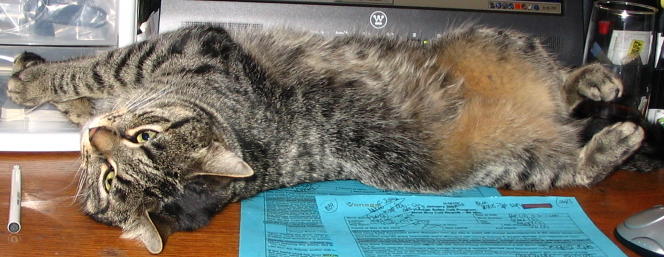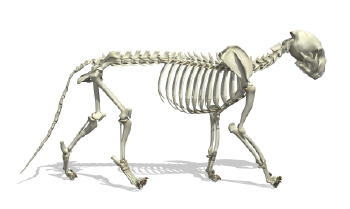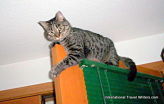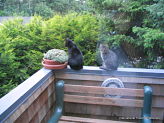Cat Bone Structure

The cat bone structure allows it to twist with part of the body going in an opposite direction to the other. Coty gives an example of this in the photo above. The beige color is her stomach area.
Their bone structure ...some cat info for help in understanding the cat bones framework and skeleton. Healthy cat bones are a major part of cat health. Cat Health and the Cat's Bone Structure go hand in hand by promoting your cat's life-long wellness. Cats are such agile and flexible critters that we often forget they have bones that are anchoring all that muscle.
The cat bone structure also provides a framework around the vital organs while manufacturing blood cells and stockpiling important minerals. By understanding how the cat bone structure handles all those essential tasks helps you appreciate their importance to your cats health.
The cat's bones are approx. 1/3 protein (primarily collagen i.e. fingernails) and 2/3 minerals (calcium & phosphorus)and a few cells scattered throughout. The collagen fibers form a net that the minerals attach to during bone formation (calcification). The combination of hard minerals and pliable protein gives the bone both the compressional strength to stand up under pressure and the tensile strength to bend without breaking....much like reinforced concrete with its mixture of hard cement and flexible wire.
Your cat's bones also contain soft bone marrow, a collection of fibrous tissue, cells, and fat. The fat stores energy, and certain marrow cells make your cat's blood. A cat's red blood cells last only about 3 months, and some of the white blood cells survive only a few hours so to keep up, a cat's bone marrow manufactures hundreds of thousands of blood cells per second.
The cat bone structure is always under construction. Like remodeling your house, a cats bones continuously reshape themselves...adding tissue in some areas and removing it from others. Modified white blood cells called osteoclasts (bone breakers) chew tunnels through old bone while smaller bone cells, the osteoblasts (bone buds) lay down new material. This remodeling tends to be faster at the end of the bone near the joint (epiphysis) than in the bone's shaft (diaphysis).
One of the main advantages of this process is that it eliminates old tissue that may be losing its resilience. A cat that is actively running and jumping is likely to have dense bones, whereas a couch-potato cat...whose bones are rarely under pressure...may be more delicate.
By continually reshuffling the mineral components in bone, remodeling also helps maintain an adequate calcium supply in the blood. Your cat needs some of the calcium released during this process to send nerve impulses, operate muscles, and form blood clots. Most of your cat's total calcium...about 99 percent...stays in the cat bone structure.
Cats have a thick skull composed of about 29 different bony parts. The feline collarbone (clavicle) is a mere sliver with no attachment to other bones, which explains why cats can squeeze their shoulders through tight spaces. Where bones meet, a smooth articular cartilage cushions the bones and keeps them from rubbing against each other. Synovial fluid within the joint capsule lubricates the moving parts like motor oil in an engine.
Cats have a loosely jointed wrist (carpus) which can rotate inward (supinate).
This comes in handy when swatting at prey or scampering up a tree.
There are two major bone types: compact bone and spongy bone. Compact
bone is sturdy but slow growing; spongy bone grows more quickly. Bone
marrow comes in two main varieties: red marrow lies in the end of the
bone and produces blood cells; yellow marrow resides in the center of
the bone and stores fat.
The bones in the feline back (thoracic and lumbar vertebrae)
have slightly looser joints than those of many other animals, which
enables cats to twist around completely while falling...and land with
all four feet on the ground.
Cats, on average, have 244 bones (about 40 more than we do). Many of the extras are in the cat's tail which has 19-28 vertebrae while our tailbone only has 4. The number of tail bones (caudal vertebrae) varies
from cat to cat. The tailless Manx has fewer than 5. The cat also has
3 more vertebrae in its back than we do. That's why your cat is so
good at stretching, twisting and curling into impossible positions and
small spaces.
Cats are fortunate that their bones rarely suffer from congenital malformations or disease and they seldom break a bone except when they are hit by a car. They are not invincible.

Related Articles......
Return from Cat Bone Structure to Cat Health Homepage
Having trouble finding what you need? Cat Health Index & Site Map
OR
Do you have a question to ask?...Questions
OR
Do you have a cat story to share?...Simply click here to go to that page!
Copyright@2010-2020 All rights reserved.Cat-health-detective.com
This website is information only. Consult a veterinarian for medical assistance

"Like Us" on Facebook
or...
"Like Us" here




















